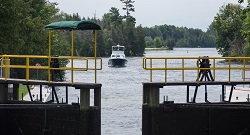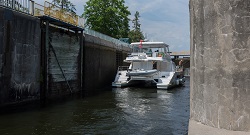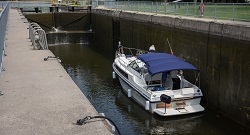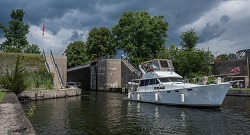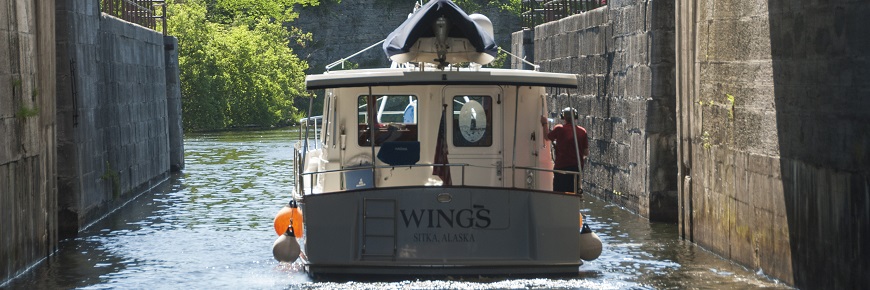
Locking through safely
Trent-Severn Waterway National Historic Site
Locks are designed to raise and lower boats from one water level to another. They were built, along with a series of dams, to bypass rapids and waterfalls. In some locations, two or more locks are joined together to overcome greater changes in water levels.
At Peterborough and Kirkfield on the Trent–Severn Waterway, hydraulic lift locks raise and lower boats in water-filled chambers counter-balanced on huge pistons. At the Big Chute Marine Railway on the Severn River, a three-storey tall carriage transports boats cradled in specially designed slings over a height of land.
Locking through safely on the Trent–Severn Waterway involves four basic steps – approaching the lock, entering the lock, what to do once inside the lock chamber and exiting the lock.
Friendly lock staff are available to help make your locking experience an easy and enjoyable one.
At some lock stations, and especially at Big Chute on the Trent–Severn Waterway, locking through instructions are often given over a P.A. system. Wait at the blue line until directed to proceed and then follow the operator’s instructions.
At swing bridges, wait until the bridge is fully open before proceeding. Travel slowly, in single file, giving way to vessels travelling downstream.
Approaching the lock
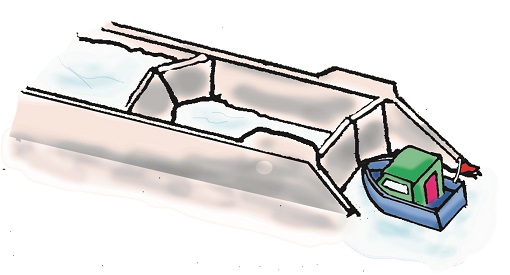
Obey any posted speed limits between locks or out on the open water. Slow your boat down to a ‘no wake’ speed. Excessive wake can erode the shoreline, damage docked boats and endanger the safety of others. Keep the channel near the lock gates clear to allow boats departing or entering the lock a safe and easy passage.
When approaching locks or swing bridges, the signal to request to enter the lock or to have the bridge opened is three long blasts of five seconds duration from a whistle, horn or siren.
During a lockage, one or both lock gates may be opened for incoming and departing vessels depending on: the size and number of vessels, proficiency of the vessel operators, or wind and wave conditions. In addition, lock staff will open both lock gates when requested to do so by a vessel operator.
The painted blue strip (blue line) above and below each lock is a temporary holding area for boaters wanting to lock through. Tie up at this blue line only if you wish passage through the lock. To avoid the risk of injury: step slowly, do not jump, from the boat to the dock/wall and only after the boat has stopped. Be cautious of uneven surfaces or ‘sink holes’ along the canal walls.
Please be patient if lock staff are not ready to lock you through immediately. They do their best to coordinate upbound with downbound lockages and may have water management duties at nearby dams as a first priority.
Entering the lock
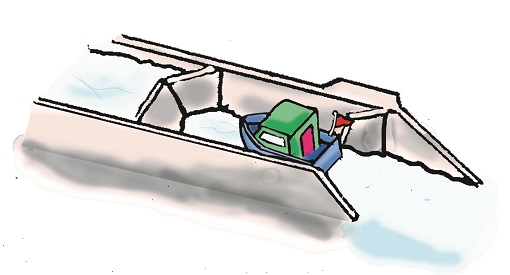
It is very important to remember that during the entire locking through process, you are under the direction of lock operations staff, so please watch for their hand signals, traffic signals or verbal commands.
After the lock gates are opened and departing vessels are clear, lock staff will direct you to enter the lock. At some Trent–Severn Waterway lock stations, a green traffic light is your signal to proceed. Approach the lock chamber cautiously and follow the instructions of staff. Be aware of wind speed, wind direction and possible cross currents. Concentrate on coming in straight and under control, using reverse gear to slow the boat down.
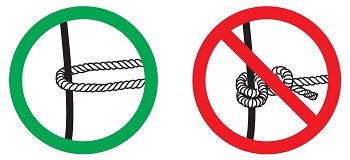
As you approach an appropriate position inside the lock, have your crew members ready to loop their vessel lines around the black drop cables. Crew members should wear their PFDs while attempting this manoeuvre; unexpected movement of the vessel could cause them to fall overboard.
Should your vessel get too close to the lock wall, use a boat hook to push yourself off. Never use your hands or feet to fend a moving boat off a lock wall. Your crew (adults if possible) should be posted at the bow and stern of your boat with mooring lines free of knots and ready to use.
Inside the lock chamber
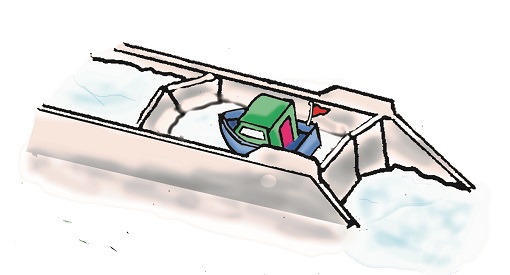
Once you have safely positioned your vessel inside the lock chamber, and looped the bow and stern lines around the black drop cables, follow these steps: (These fire safety symbols appear on lock gate signs at the lock station)
-

Turn off all ignition switches (engine, generators etc.). Do not restart or idle your engine during the lockage procedure.
-

Turn off all open-flame appliances, including pilot lights, gas powered generators and barbeques.
-

Do not smoke above or below vessel deck.
-

Leave the bilge blower on throughout the lockage procedure.
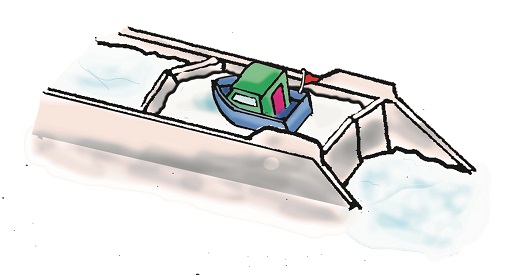
Tend your lines carefully during the lockage. Never leave your bow or stern line unattended. Always be prepared to show your lockage permit to staff or be ready to purchase one from them.
Exiting lock

When the lock operation is completed and lock gate(s) are opened, for safety reasons, please do not restart your engine until directed to do so by lock staff. Check to make sure bow and stern lines are back on your boat and please exit slowly. Exit in order if necessary, or as directed by staff, and remember to watch out for winds, currents and other boats.
- Date modified :
